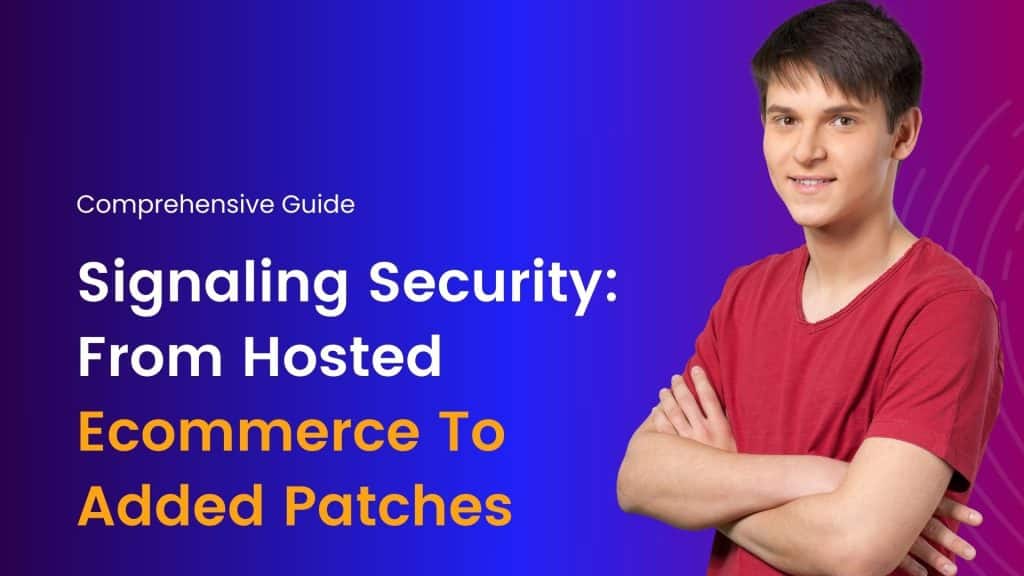In today’s digital age, security is paramount for any online business. The rise of eCommerce has brought convenience and accessibility to consumers worldwide, but it has also opened the door to various security threats. From data breaches to cyberattacks, eCommerce platforms must prioritize security to protect their customers and maintain their reputation. This article explores the importance of signaling security, the transition from hosted eCommerce solutions to more secure options, and the role of added patches in maintaining a robust security posture.
The Importance of Signaling Security
In the rapidly evolving digital landscape, signaling security has emerged as a critical priority for businesses and consumers alike. As cyber threats become more sophisticated and pervasive, the need for robust security measures has never been more urgent. This article explores the importance of signaling security, particularly in the context of hosted e-commerce platforms, and the role of added patches in fortifying these systems.
Understanding Signaling Security
Signaling security refers to the mechanisms and protocols designed to protect communication signals from interception, tampering, and unauthorized access. This concept is crucial in various domains, including telecommunications, internet communications, and data exchanges in e-commerce. Effective signaling security ensures that data transmitted over networks remains confidential, authentic, and unaltered.
The Critical Role of Signaling Security in Hosted E-commerce
Hosted e-commerce platforms, which provide businesses with a ready-to-use infrastructure for online sales, have revolutionized the way goods and services are traded. However, the convenience and scalability of these platforms also come with significant security challenges. Here’s why signaling security is paramount in this context:
Protecting Sensitive Information
E-commerce transactions involve the exchange of sensitive information, such as credit card details, personal identification data, and login credentials. Without robust signaling security, this information can be intercepted by malicious actors, leading to identity theft, financial fraud, and other serious consequences.
Maintaining Consumer Trust
Consumers trust e-commerce platforms with their personal and financial data. Any breach or security incident can severely damage this trust, leading to loss of customers and revenue. Signaling security helps in safeguarding this trust by ensuring that data transmissions are secure and reliable.
Compliance with Regulations
Many regions have stringent regulations regarding data protection and cybersecurity, such as the General Data Protection Regulation (GDPR) in Europe and the California Consumer Privacy Act (CCPA) in the United States. E-commerce platforms must implement strong signaling security measures to comply with these regulations and avoid hefty fines.
Preventing Data Breaches
Data breaches can have devastating effects on businesses, including financial losses, legal repercussions, and reputational damage. Signaling security plays a crucial role in preventing data breaches by securing communication channels and thwarting potential cyber-attacks.
The Role of Added Patches in Enhancing Security
In the realm of cybersecurity, patches refer to updates or fixes provided by software vendors to address vulnerabilities and improve security. Regularly applying patches is a vital aspect of maintaining signaling security in hosted e-commerce platforms.
Addressing Vulnerabilities
Cyber threats continuously evolve, and new vulnerabilities are discovered regularly. Patches address these vulnerabilities by fixing security flaws and updating protocols to counteract emerging threats. This ongoing process is essential for staying ahead of cybercriminals.
Improving System Performance
In addition to security enhancements, patches often include performance improvements and bug fixes. By keeping systems up-to-date, businesses can ensure that their e-commerce platforms run smoothly and efficiently, providing a better user experience.
Ensuring Compatibility
As technology advances, new software and hardware may require compatibility updates. Patches ensure that all components of the e-commerce platform work seamlessly together, preventing potential security gaps caused by outdated or incompatible systems.
Compliance and Certification
Applying patches is often a requirement for compliance with industry standards and certifications. For instance, the Payment Card Industry Data Security Standard (PCI DSS) mandates regular updates and patch management as part of its security requirements for handling credit card transactions.
Best Practices for Signaling Security and Patch Management
To effectively safeguard e-commerce platforms, businesses should adopt a comprehensive approach to signaling security and patch management. Here are some best practices to consider:
Regular Security Audits
Conduct regular security audits to identify potential vulnerabilities and assess the effectiveness of existing security measures. Audits should cover all aspects of the e-commerce platform, including communication protocols, data storage, and user authentication.
Timely Patch Application
Establish a systematic patch management process to ensure timely application of updates. This includes prioritizing patches based on the severity of vulnerabilities and testing them in a controlled environment before deployment.
Encryption and Secure Protocols
Implement strong encryption methods and secure communication protocols, such as HTTPS and Transport Layer Security (TLS), to protect data in transit. Encryption ensures that even if data is intercepted, it remains unreadable to unauthorized parties.
User Education and Awareness
Educate users, including employees and customers, about the importance of cybersecurity and safe online practices. Encourage strong password policies, regular software updates, and vigilance against phishing attacks.
Multi-Factor Authentication (MFA)
Deploy multi-factor authentication to add an extra layer of security to user accounts. MFA requires users to provide multiple forms of verification, such as a password and a temporary code sent to their mobile device.
In the dynamic world of e-commerce, signaling security is a cornerstone of safeguarding sensitive information, maintaining consumer trust, and ensuring regulatory compliance. Hosted e-commerce platforms, while offering numerous advantages, must prioritize signaling security and adopt robust patch management practices to protect against evolving cyber threats. By implementing comprehensive security measures and staying vigilant, businesses can create a secure and trustworthy online shopping experience for their customers.
Transitioning from Hosted eCommerce Solutions
n the ever-evolving digital marketplace, eCommerce businesses face numerous challenges, with security being at the forefront. As companies scale and diversify, the need to transition from hosted eCommerce solutions to more secure and customizable alternatives becomes paramount. This transition, while beneficial, demands careful consideration and implementation of robust security measures, including the integration of added patches.
Understanding Hosted eCommerce Solutions
Hosted eCommerce solutions, such as Shopify, BigCommerce, and WooCommerce, provide a convenient, all-in-one platform for businesses to manage their online stores. These solutions offer ease of use, integrated payment gateways, and customer support, making them ideal for startups and small businesses. However, as businesses grow, they often encounter limitations in customization, scalability, and security.
The Limitations of Hosted Solutions
- Customization Constraints: Hosted platforms typically offer a limited range of themes and plugins, restricting businesses from fully customizing their online stores to meet unique branding and functional requirements.
- Scalability Issues: As traffic and transaction volumes increase, hosted solutions may struggle to handle the load efficiently, leading to slower website performance and potential downtime.
- Security Concerns: While hosted solutions provide basic security measures, businesses often need more advanced security features to protect sensitive customer data and transactions.
The Shift to Customizable eCommerce Platforms
To overcome these limitations, many businesses transition to self-hosted or customizable eCommerce platforms such as Magento, WooCommerce (self-hosted), or custom-built solutions. These platforms offer greater flexibility, allowing businesses to tailor their online stores to specific needs and scale as required.
Benefits of Customizable Platforms
- Enhanced Customization: Businesses can design and develop unique features, integrate third-party applications, and create a seamless user experience.
- Improved Scalability: Customizable platforms can be optimized to handle increased traffic and transaction volumes, ensuring smooth and uninterrupted operations.
- Advanced Security: Businesses can implement sophisticated security measures, including regular updates and patches, to protect against evolving cyber threats.
Signaling Security with Added Patches
One of the critical aspects of transitioning to a customizable eCommerce platform is the implementation of security patches. Patches are updates released by software vendors to fix vulnerabilities, enhance functionality, and improve overall security. Here’s how businesses can effectively signal and ensure security through added patches:
Regular Updates and Maintenance
Staying up-to-date with the latest patches is crucial. Businesses should establish a routine schedule for applying patches and updates to their eCommerce platform, ensuring that all security vulnerabilities are promptly addressed.
Automated Patch Management
Leveraging automated patch management tools can streamline the process of identifying, testing, and deploying patches. Automation reduces the risk of human error and ensures that critical updates are not overlooked.
Comprehensive Testing
Before deploying patches, businesses should conduct thorough testing in a staging environment. This helps identify potential conflicts or issues that could disrupt website functionality, ensuring a smooth transition when the patch is applied to the live site.
Monitoring and Alerts
Implementing monitoring tools and alert systems can help detect unusual activities or vulnerabilities that may require immediate attention. Real-time monitoring enables businesses to respond quickly to potential security threats.
Collaboration with Security Experts
Partnering with cybersecurity experts can provide valuable insights and guidance on best practices for patch management. Security professionals can help businesses develop robust strategies to safeguard their eCommerce platform.
Communicating Security to Customers
Transparency in security practices builds trust with customers. Businesses should communicate their commitment to security through clear messaging on their website and during the checkout process. This includes highlighting the use of secure payment gateways, SSL certificates, and regular security updates.
Transitioning from hosted eCommerce solutions to customizable platforms offers numerous benefits, including enhanced customization, scalability, and security. However, the success of this transition hinges on the effective implementation of security measures, particularly the regular application of patches. By prioritizing security and communicating their efforts to customers, businesses can create a safe and reliable online shopping experience, fostering customer trust and loyalty in the competitive eCommerce landscape.
The Role of Added Patches
Maintaining a secure eCommerce platform is an ongoing process that requires continuous monitoring and updating. One of the most critical aspects of this process is the application of added patches. Patches are updates that fix security vulnerabilities, bugs, and other issues in software. They play a vital role in ensuring the security and stability of eCommerce platforms:
- Vulnerability Management: Cybercriminals constantly search for vulnerabilities in software to exploit. Regularly applying patches helps to close these security gaps, reducing the risk of attacks.
- Performance Improvements: Patches often include performance enhancements that improve the overall functionality and user experience of the eCommerce platform. A well-maintained platform is not only secure but also efficient.
- Regulatory Compliance: Many regulatory frameworks require businesses to maintain up-to-date software to protect customer data. Applying patches promptly helps eCommerce platforms comply with these regulations and avoid potential fines.
- Protecting Customer Data: The primary goal of eCommerce security is to protect customer data. Patches address known vulnerabilities that could compromise sensitive information, ensuring that customer data remains confidential and secure.
Best Practices for Implementing Security Measures
To maximize the effectiveness of signaling security, transitioning to secure options, and applying patches, eCommerce platforms should follow these best practices:
- Regular Security Audits: Conduct regular security audits to identify potential vulnerabilities and ensure compliance with industry standards. This proactive approach helps to address issues before they can be exploited.
- Employee Training: Educate employees about security best practices and the importance of maintaining a secure environment. Well-informed staff can help to prevent accidental security breaches and recognize potential threats.
- Monitoring and Incident Response: Implement continuous monitoring to detect suspicious activity and respond to incidents promptly. A robust incident response plan ensures that security breaches are handled efficiently, minimizing damage.
- Backup and Recovery: Regularly back up critical data and establish a comprehensive recovery plan. In the event of a security breach, having reliable backups ensures that the business can quickly recover and resume operations.
“Ensure your eCommerce platform is secure. Prioritize signaling security, transition to more secure hosting, and keep your software updated with essential patches. Protect your business and customers today! Sign Up Hostao Today”
Conclusion
In the ever-evolving landscape of eCommerce, security is a critical component of success. Signaling security through visible measures, transitioning to more secure hosting options, and diligently applying patches are essential steps in protecting customer data and maintaining trust. By prioritizing security, eCommerce platforms can not only safeguard their customers but also gain a competitive edge in the marketplace.
I'm a tech-savvy writer with a Computer Science degree and web hosting background, contributing to Hostao Blogs. I simplify complex tech topics like web development and cybersecurity. Beyond writing, I'm a tech explorer passionate about digital advancements.




















